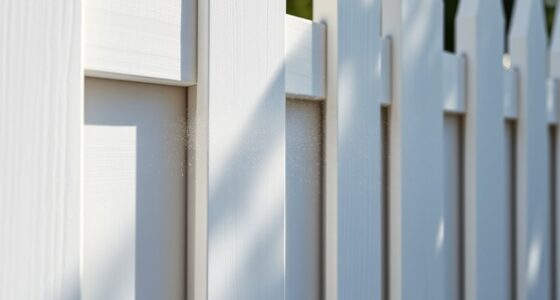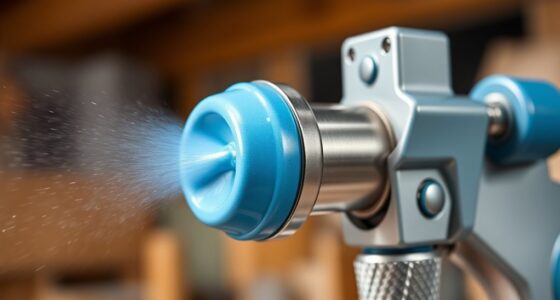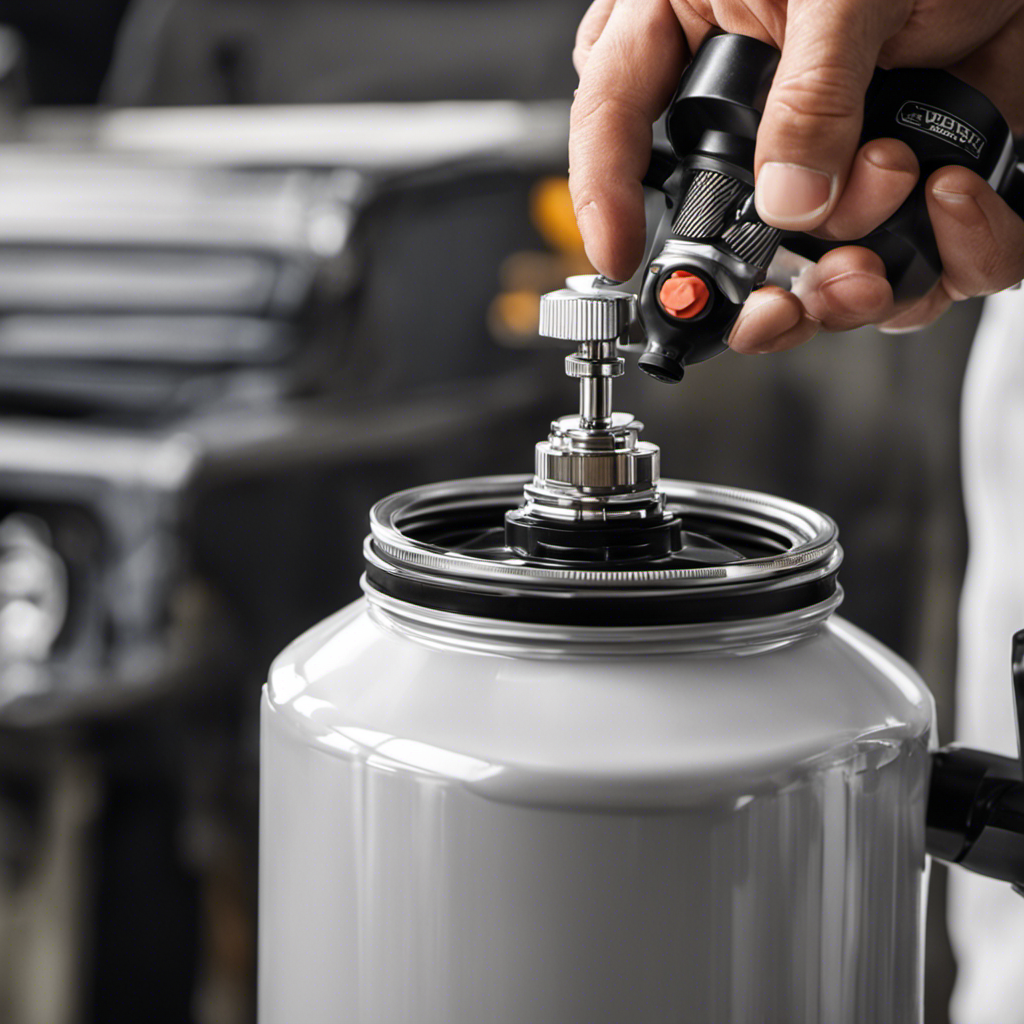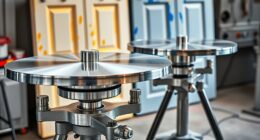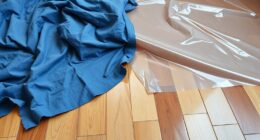Yes, you can definitely use a paint sprayer for small touch-ups. Small electric or HVLP sprayers are perfect because they give you precise control and minimize overspray. They work well on tricky spots, textured surfaces, and tight corners, saving you time and effort. To get the best results, proper surface prep and equipment setup are key. Keep exploring, and you’ll discover how to achieve a smooth, professional finish with ease.
Key Takeaways
- Yes, small electric or HVLP sprayers are ideal for precise, controlled touch-up work.
- Proper surface cleaning and preparation ensure good adhesion and smooth finishes with sprayers.
- Adjust spray pattern, pressure, and distance for even coverage on small areas.
- Practice on scrap surfaces to master technique and avoid drips or overspray.
- Using the right equipment and techniques results in efficient, professional-looking small touch-ups.
Types of Paint Sprayers Suitable for Small Projects
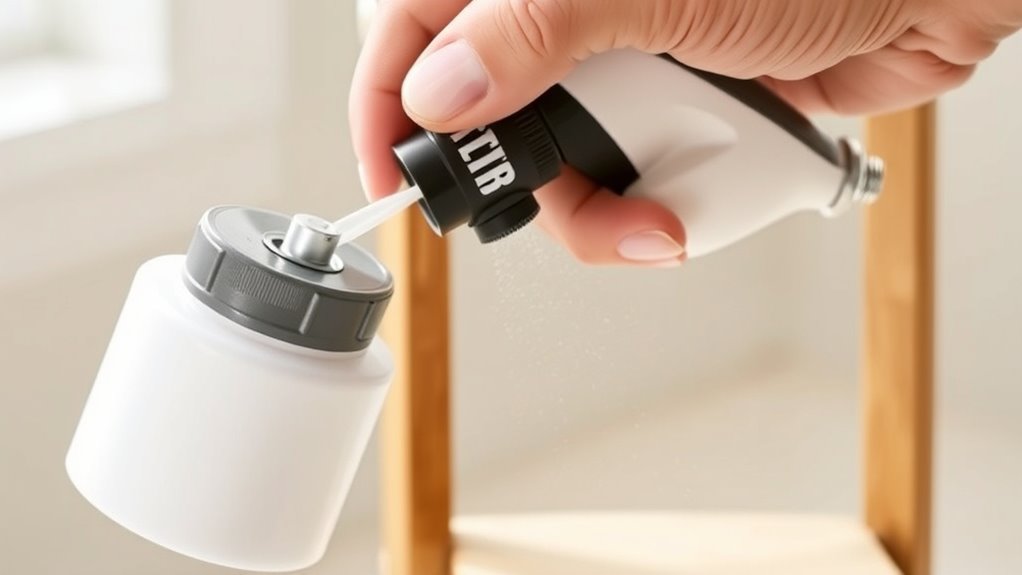
When tackling small touch-up projects, choosing the right type of paint sprayer can make all the difference. For such projects, consider handheld or smaller electric sprayers that offer precise control. These sprayers work well with different brush types, allowing you to apply paint smoothly in tight spots. If you’re matching paint color, a sprayer with adjustable settings helps you blend seamlessly with existing paint. HVLP (High Volume Low Pressure) sprayers are popular because they reduce overspray and are easy to maneuver. Airless sprayers can also be suitable for small jobs if you need a quick, even coat. Ultimately, select a sprayer that offers fine control, so you can focus on detail work without mess or waste. Additionally, understanding AI’s role in paint technology can help you choose sprayers with advanced features that improve precision and efficiency. Modern advancements in automotive tuning have also led to the development of specialized spray systems that enhance application quality and consistency.
Advantages of Using a Paint Sprayer for Touch-Ups

Using a paint sprayer for touch-ups offers several clear advantages that can save you time and improve the results. It enables you to achieve smooth, even coverage quickly, especially for small areas. Plus, it makes color matching easier, helping your touch-up seamlessly blend with the surrounding wall. You also benefit from less paint waste since sprayers allow precise application, reducing paint disposal. Additionally, a sprayer reaches tricky spots and textured surfaces more effectively than brushes or rollers. Here’s a quick overview:
| Advantage | Benefit | Key Point |
|---|---|---|
| Faster application | Saves time on small projects | Ideal for quick touch-ups |
| Better color matching | Blends seamlessly with existing paint | Achieves uniform finish |
| Reduced paint disposal | Less waste, more efficiency | Cost-effective process |
Using a paint sprayer for touch-ups can also help minimize equipment setup, making the entire process more efficient. Proper technique and maintenance are essential to maximize the benefits of your sprayer. Regular cleaning and inspection of hoses and seals help prevent issues like clogs or leaks, ensuring smooth operation. Additionally, understanding proper pressure settings can significantly improve your results and avoid overspray or uneven application. Maintaining filtering and pump protection is also vital to keep your sprayer functioning optimally over time.
Potential Challenges and How to Overcome Them

While paint sprayers offer many benefits for small touch-up jobs, they also present some challenges that you need to be aware of. Drip issues can occur if you hold the sprayer too close or press the trigger too long, leading to uneven spots. To avoid this, maintain a consistent distance and use smooth, sweeping motions. Overspray challenges are common, especially in tight spaces, resulting in paint accumulating where it’s not wanted. To minimize overspray, adjust your sprayer’s pressure and use masking tape or drop cloths to protect surrounding surfaces. Practice on a scrap piece first to get comfortable with the spray pattern. Being mindful of these potential problems and taking preventative steps will help you achieve a clean, professional touch-up. Additionally, understanding the benefits of proper technique can significantly enhance your results and prevent common mistakes. Proper paint application techniques are essential for achieving a smooth and even finish, especially in delicate or detailed areas. Practicing these techniques and understanding sprayer adjustments can make a notable difference in your overall outcome. Moreover, familiarizing yourself with Nissan tuning principles can help you optimize your vehicle’s performance and appearance after completing your paint touch-up. A good grasp of spray pattern control can also help in achieving more precise and consistent results.
Preparing Your Surface and Equipment for Best Results
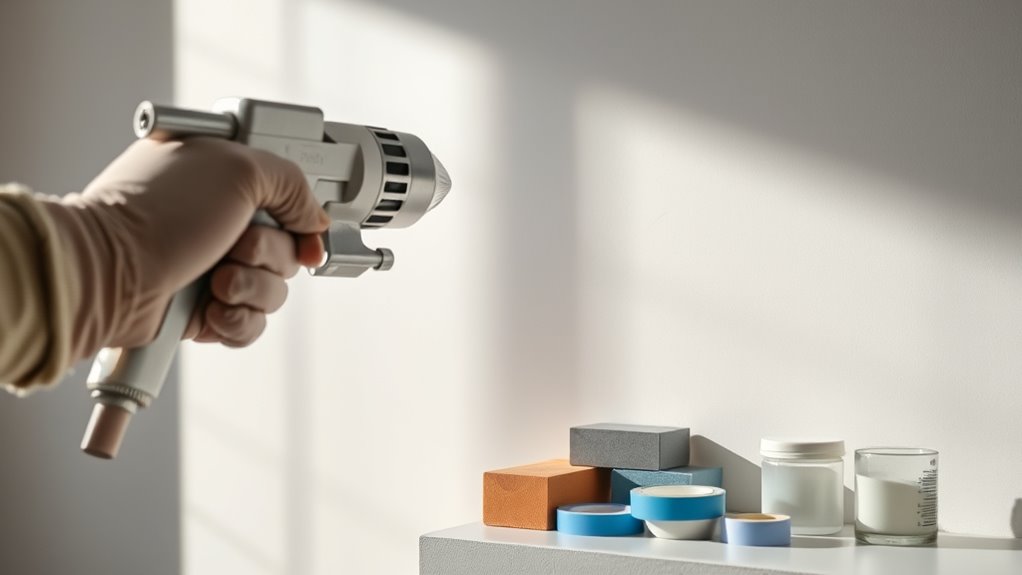
Before you start spraying, make sure your surface is clean and free of dust, grease, or old paint, as this ensures a smooth finish. Set up your equipment properly, checking that the spray gun is adjusted and the pressure is right for your project. Finally, keep your paint at the right consistency to prevent drips or uneven coverage. Additionally, ensure proper airflow around your equipment to enhance air purifier maintenance and prevent overheating during use. Regularly inspecting your spray equipment can help identify potential issues early, improving overall payment security and preventing malfunctions during operation. Monitoring equipment for proper proper airflow can also contribute to achieving a more even application and is essential for maintaining automation efficiencies in your process. Incorporating AI-driven diagnostics can further optimize equipment performance and longevity.
Surface Cleaning Techniques
Proper surface preparation is essential for achieving a smooth, professional finish with your paint sprayer. Before spraying, thoroughly clean the surface to remove dust, grease, and old paint, ensuring even color matching and environmental safety. Use a gentle cleaner or mild detergent, avoiding harsh chemicals that could harm the environment. For stubborn grime, a soft scrub brush works best. Keep equipment clean by rinsing components regularly to prevent clogs and ensure ideal spray patterns. To keep things interesting, consider this table:
| Surface Type | Cleaning Method | Tips |
|---|---|---|
| Wood | Soap & water | Sand lightly afterward |
| Metal | Degreaser | Rinse thoroughly |
| Drywall | Vacuum & dust | Seal before painting |
Clean surfaces promote better adhesion and a flawless finish. Additionally, surface preparation can significantly reduce the need for touch-ups later on. Properly preparing your surface not only improves the quality of your paint job but also extends the lifespan of your paint. Taking the time to prepare surfaces properly ensures a more durable and professional-looking result. Regular maintenance and cleaning of your tools and surfaces are also vital to prevent issues like clogging during application. Recognizing the importance of surface cleanliness can lead to more successful painting projects with fewer flaws.
Proper Equipment Setup
Setting up your paint sprayer correctly starts with guaranteeing both your surface and equipment are prepared for ideal results. You’ll want to select the right brush types for touch-ups, such as fine detail brushes, to complement your spray work. Proper paint mixing is essential—thoroughly stir or strain your paint to prevent clogs and uneven application. Before spraying, test your equipment on a scrap surface to adjust spray patterns and pressure. Keep in mind these key points:
- Use appropriate brush types for precise touch-ups around edges.
- Mix paint well to achieve a smooth, consistent flow.
- Adjust your sprayer’s settings to match the project size and surface.
- Regular maintenance and proper GMC tuning can improve your spray application and finish quality.
- Remember that cultural references in literature can add depth and personality to your communication, enhancing your presentation and making your tips more memorable.
Additionally, understanding how Volkswagen Tuning influences engine performance can help you better calibrate your equipment for different materials and finishes. Proper Honda Tuning techniques can also inform your approach to achieving a smooth, professional-looking coat.
This preparation helps ensure a flawless finish with minimal overspray or mess.
Paint Consistency Tips
Ensuring your paint has the right consistency is essential for achieving smooth, even touch-ups. You want your paint to flow easily through the sprayer without splattering or drips. If it’s too thick, thin it slightly with the appropriate solvent, and if it’s too thin, add a small amount of paint to thicken it. Proper paint color coordination is key to blending touch-ups seamlessly, so always test your paint on a small area first. Keep in mind that paint drying time can vary based on the consistency, so avoid overworking the area before it’s fully dry. Consistent paint thickness helps ensure a uniform finish and minimizes the need for multiple coats, making your small touch-up job look professional and flawless.
Step-by-Step Guide to Using a Paint Sprayer for Small Areas
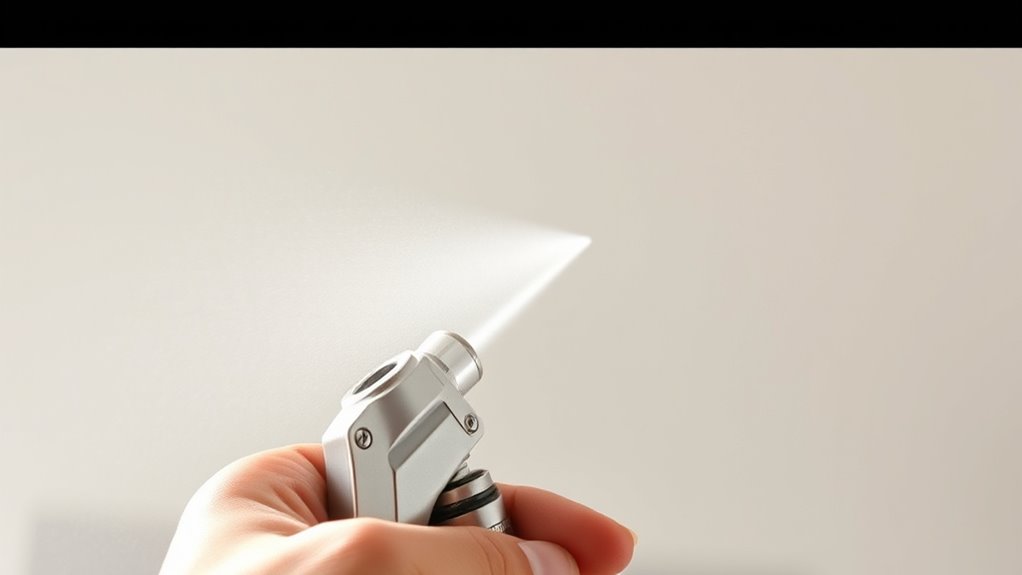
Using a paint sprayer for small touch-ups can be quick and effective if you follow the right steps. First, prepare your workspace by covering nearby surfaces and ensuring the area is clean. Next, check your paint color matching to get an exact shade, and perform brush maintenance on tools used previously to prevent mixing old paint. Before spraying, test your sprayer on a scrap surface to adjust the flow and spray pattern. When ready, hold the sprayer about 6-12 inches from the surface, using smooth, steady motions. Keep a consistent distance and overlap each pass for even coverage. After finishing, clean your sprayer thoroughly to maintain proper brush upkeep and ensure it’s ready for your next project.
Tips for Achieving a Smooth, Professional Finish
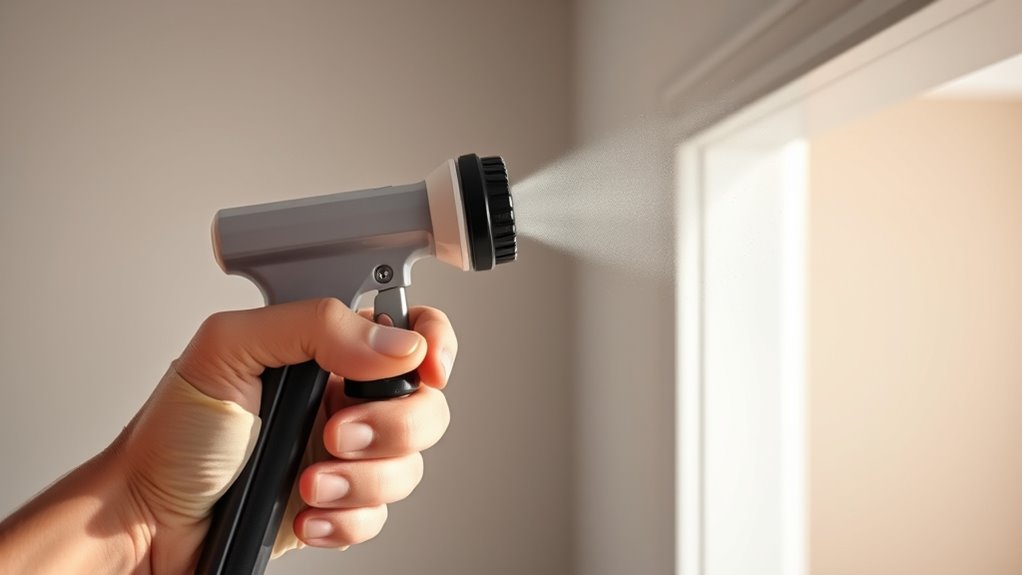
To get a smooth, professional finish, start with the right equipment that suits your project. Keep your technique consistent to avoid uneven spray patterns, and always prepare your surface properly for the best results. Paying attention to these key points can make a big difference in your touch-up work.
Proper Equipment Selection
Choosing the right spray gun and nozzle size is vital for achieving a smooth, professional finish on small touch-up projects. Selecting the correct equipment ensures even paint application and helps prevent overspray. Focus on a spray gun with adjustable settings for better control. Use a nozzle size suitable for detail work—typically 0.8 to 1.0 mm for small areas. Proper brush maintenance is also essential; clean your tools thoroughly to avoid clogs and ensure consistent paint flow. When matching colors, choose equipment that allows precise control to blend seamlessly with existing paint. Additionally, selecting the right equipment reduces the need for multiple coats, saving time and effort. With the correct tools and attention to detail, you’ll achieve flawless results with minimal hassle.
Consistent Technique Application
Achieving a smooth, professional finish with your paint sprayer requires maintaining a consistent technique throughout the project. Start by mastering your brush techniques for touch-ups, using controlled, even strokes to blend edges seamlessly. Keep your spray pattern steady, moving at a consistent speed to avoid drips or uneven coverage. Proper paint mixing is vital; confirm your paint is thinned appropriately to prevent clogging and achieve a smooth spray. Regularly check your spray gun’s pressure and nozzle to maintain uniform output. Practice on scrap surfaces if needed, focusing on maintaining the same distance and angle. By staying mindful of your brush techniques and keeping paint well-mixed, you’ll guarantee each pass results in a flawless, professional-looking finish.
Surface Preparation Matters
Proper surface preparation sets the foundation for a flawless paint job. Before using your paint sprayer for small touch-ups, guarantee the surface is clean, dry, and smooth. This step prevents uneven finishes and reveals wall texture considerations that might affect coverage. If you’re considering paint roller alternatives, like brushes or sponges, choose the right tool for detailed areas. Sand rough patches and fill holes to create an even surface. Remove dust and grease to avoid imperfections. Remember, a well-prepared wall enhances paint adhesion and results in a professional look. Keep in mind wall texture considerations—rough textures may require different spraying techniques or additional prep work. Proper prep saves time and ensures your touch-up blends seamlessly with the existing finish.
Frequently Asked Questions
Can I Use Any Type of Paint in a Sprayer for Small Touch-Ups?
When considering whether you can use any type of paint in a sprayer for small touch-ups, think about paint viscosity and sprayer compatibility. Thinner paints with lower viscosity work better, as they flow smoothly through the sprayer without clogging. Always check the sprayer’s manual to verify the paint type is compatible. Using the right paint ensures a clean finish and prevents damage to your sprayer.
How Precise Can a Paint Sprayer Be for Detailed Small-Area Work?
Think of a paint sprayer as a precision instrument—its spray accuracy can be surprisingly high, especially with the right equipment. For fine detail work, you’ll find that some sprayers allow you to control the flow and spray pattern closely, making small-area touch-ups feasible. However, achieving perfect precision depends on the sprayer’s design and your technique, so select one suited for detailed work to guarantee smooth, accurate results.
Is a Paint Sprayer More Cost-Effective Than Brushes for Small Repairs?
When comparing cost, a paint sprayer can be more efficient for small repairs because it covers large areas quickly, reducing labor time. While brushes may seem cheaper upfront, the cost comparison favors sprayers over time due to their efficiency benefits and less paint waste. If you’re looking to save on both time and materials, a paint sprayer offers a practical, cost-effective solution for small touch-ups.
What Safety Precautions Are Necessary When Using a Sprayer Indoors?
Using a paint sprayer indoors is like releasing a mini hurricane, so safety’s a must! You’ll need excellent ventilation safety—think fans blasting, doors wide open—and protective gear like masks, goggles, and coveralls. Don’t forget to seal the room and keep pets and kids away. These precautions keep you safe from overspray and fumes, making your project safer and less chaotic—so you can enjoy your masterpiece without worry!
How Do I Clean a Paint Sprayer After a Small Project?
When cleaning your paint sprayer after a small project, you should follow some simple cleaning tips. First, empty the remaining paint and rinse the sprayer with water or solvent, depending on your paint type. Disassemble key parts for thorough cleaning. Proper sprayer maintenance involves wiping down components and lubricating moving parts. This guarantees your sprayer stays in good shape for future projects and works smoothly every time.
Conclusion
Using a paint sprayer for small touch-ups is a smart choice, offering quick and even coverage. With over 60% of homeowners preferring sprayers for repairs, it’s clear they’re popular for precision work. Just remember to choose the right sprayer, prep your surface, and follow proper techniques. With patience and practice, you’ll achieve a smooth, professional finish every time—making your small project look flawless in no time.
A seasoned painter with over 15 years in the industry, Mike transitioned from hands-on painting projects to the digital world of paint sprayers. His extensive experience gives him a unique perspective on what users truly need when it comes to painting tools. As the Editor in Chief of Paint Sprayer Zone, Mike ensures that every piece of content not only provides value but also reflects the realities of painting — the challenges, the joys, and the intricate details.



